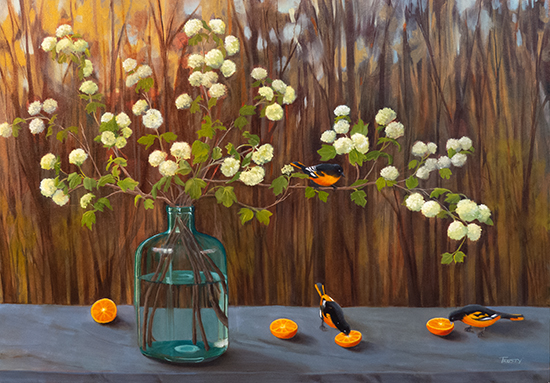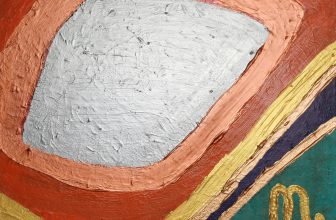
Wild Things
Perspectives from The Artist’s Road

The Orioles Arrive 30 x 40″ Oil © Ann Trusty
We are happy to see that the Baltimore Orioles have arrived this week to our yard in Kansas on their epic flights from Central America. We are lucky to live under a great migratory flyway used by hundreds of millions of birds on their way north to their ancestral breeding grounds each spring. Last night, according to BirdCast data, 2,952,400 birds crossed overhead! It is an ancient and mysterious miracle of Nature of which many people are largely unaware. (We try to help by turning off unnecessary lights).
We think that the Orioles who stay and do not move on further north may be returning to their breeding and/or birth places here in this forest we have the privilege of caring for. We don’t know by what magic they arrive at our little feeders, but are grateful for their beautiful, cheery, life-affirming presences. In plentiful years, we have had up a dozen birds on the feeders in the yard or eating oranges on our back deck! It is an art-inspiring sight, and so we paint them, or attempt to.
Of course, the trouble with drawing and painting live birds is that they rarely stop moving. Other than refilling the feeders with grape jelly, they care not at all about our doings, much less about sitting for a portrait! Perhaps that is part of our attraction to these beautiful wild beings. Doing as Audubon did and shooting them is unthinkable, illegal, and would result, as it did for him, in decidedly unnatural poses and probably a lifetime of mea culpas. And we have found that a camera is only a rough tool for anyone considering birds as subject for painting. The best solution that we can recommend is a combination of lots of quiet observation and sketching, along with taking some photos. Moreover, drawing works some magic of its own on the memory in a way nothing else does. We call it, “putting it in the library”, for once a thing is carefully drawn, it can always be recalled. It is as if we now own that image. Painting from a drawing is likely to look more natural than painting only from a photograph. The eye and the mind can somewhat “distill” the look of a moving bird or animal from many minutes or hours of observation.
We know a number of top-notch animal artists whose work stands out from across the room because they have a thorough understanding of the anatomy of their subjects—the skeleton and muscles and how they move. This is a good practice for the painter of any living being. That understanding is why Walt Disney often brought live animals (think Bambi) into the studio for his animators to thoroughly study. Perhaps above all, it is very pleasant work to study birds and try to bring them to life on canvas. It teaches us a lot about them and grows our respect for the lives of wild things.
Copyright Hulsey Trusty Designs, L.L.C. (except where noted). All rights reserved.







